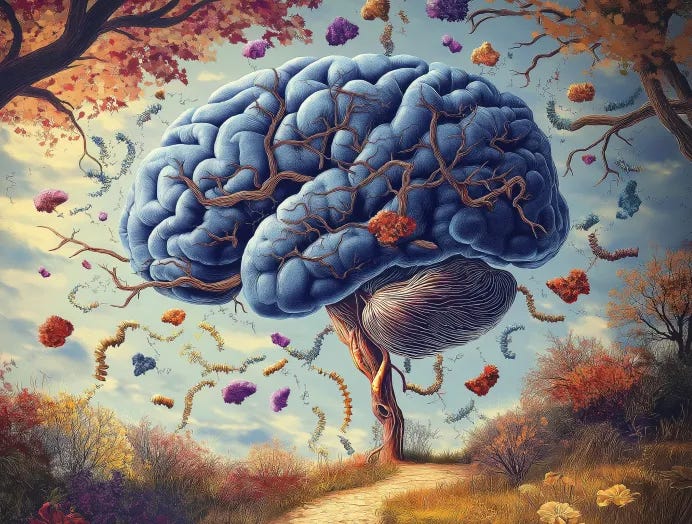Don't be fooled. Alzheimer's is a dis-ease of midlife which manifests in late life.
Little Empty Boxes - the first documentary on Alzheimer's prevention.
Dear friends,
Hope you are well too! It’s sunny and foggy in Dublin. Quite amazing to walk on the west pier and see the fog drifting in at speed and the entrance to the harbour disappearing completely in ten minutes.
Let's delve into the unsettling reality of Alzheimer's disease. It's a silent thief, indeed. As amyloid plaques and tau tangles silently accrue in the brain, tau tangles, in particular, wreak havoc on the brain's intricate communication network, ultimately leading to cell death and cognitive decline.
Let's break down tau's normal function:
Tau is a protein that resides among neurons (brain cells), and its primary role is to stabilise microtubules, which act as the internal scaffolding within these cells. Microtubules are responsible for transporting nutrients, molecules, and other essential substances throughout the neuron. However, in Alzheimer's disease, the tau protein undergoes a chemical alteration, becoming overloaded with phosphate molecules. This causes the tau molecules to detach from the microtubules and clump together inside the neuron, forming what we call tau tangles.
The destructive impact is multifold:
When tau detaches from microtubules, they destabilise and eventually disintegrate, disrupting the neuron's transport system. As a result, the cell is starved of essential nutrients and signals that would normally reach different parts of the cell. This disruption of the transport system further impairs communication between neurons, as they lose their ability to effectively send and receive signals. It's a complete communication breakdown.
What is the brain left with? Apart from the disruption of the transport system and communication, there's a toxic build-up of tau tangles, ultimately leading to the death of brain cells. It's a horrific prospect, and as if that weren't enough, there may be more to the story.
This article from Nature, "Oligodendrocytes produce amyloid-β and contribute to plaque formation alongside neurons in Alzheimer’s disease model mice", suggests that other cell types might contribute to the disease process. While it's important to acknowledge the study used mice, it hints at a more complex picture.
Even though we know that brain cell regeneration is possible, it seems like an insurmountable task if one needs to start from scratch. The documentary Fantastic Fungi offers a fascinating visual representation of how new connections are established in the brain – another worthwhile watch.
All of this cognitive decline unfolds silently in the background, and by the time a diagnosis is made, the chances of effective treatment have dwindled. The brain changes begin decades before any symptoms manifest, leaving us to grapple with other contributing factors.
Most would agree that improving cardiovascular health (managing high blood pressure, high cholesterol, and diabetes), metabolic health (addressing insulin resistance and obesity), and lifestyle factors (such as incorporating regular exercise, a healthy diet, and adequate sleep) can significantly enhance the quality of life for those we care for.
I've personally found that Pure Magnesium Bisglycinate has been a game-changer for better, more restful sleep. It benefits both my mum and me! I used to take magnesium solely for muscle recovery after training, but switching to this form has made a remarkable difference in my sleep quality. A word of caution, though: a couple of hours after taking it, I feel quite sleepy, and if I don't seize that moment, falling asleep becomes more challenging. It simplifies my routine – everything is switched off, and we prepare for bed.
Addressing these modifiable risk factors could be instrumental in preventing Alzheimer's disease. Joe Rogan and Max Lugavere delve into this topic in detail in this podcast episode. They discuss the previous week's topic (fraud) and provide a clear explanation of the core issue. All of this is covered within the first twenty minutes, offering a concise overview of the previous and current week's topics.
Max also touches upon Parkinson's disease, Type 3 diabetes, ATP production, and the work of Suzanne de la Monte, whom you might recognise from the documentary Empty Little Boxes. He also elucidates the relationship between environmental exposure, pesticides, and the vast array of compounds we inhale regularly.
So, where do we go from here? It's clear that cognitive assessments, often only effective in detecting Alzheimer's in its later stages, are insufficient for early diagnosis. We urgently need reliable methods for early detection of Alzheimer's pathology, long before symptoms surface.
If cognitive assessments alone are inadequate, what other options are there? Blood tests that identify specific proteins associated with Alzheimer's and brain imaging techniques that detect amyloid plaques and tau tangles seem like promising avenues for early detection. This early detection would allow for timely interventions to slow down, and potentially halt, the progression of this silent disease. It would enable us to initiate treatment before the extensive damage observed in later life occurs.
Lifestyle interventions such as diet modification, regular exercise, cognitive training, and stress management appear to be ideal strategies for risk reduction. And we need these interventions to be implemented swiftly. Only intervention can alter the course of this disease.
This shift in focus from ineffective late-stage treatment to early intervention is critical. It demands a multi-faceted approach encompassing research, public awareness campaigns, and healthcare policies that prioritise early detection and intervention strategies. Service providers also need to be on board with this paradigm shift.
Want to learn more? Listen to the JRE podcast episode that inspired this article:
Until next time,
Bee well,
Xanda





